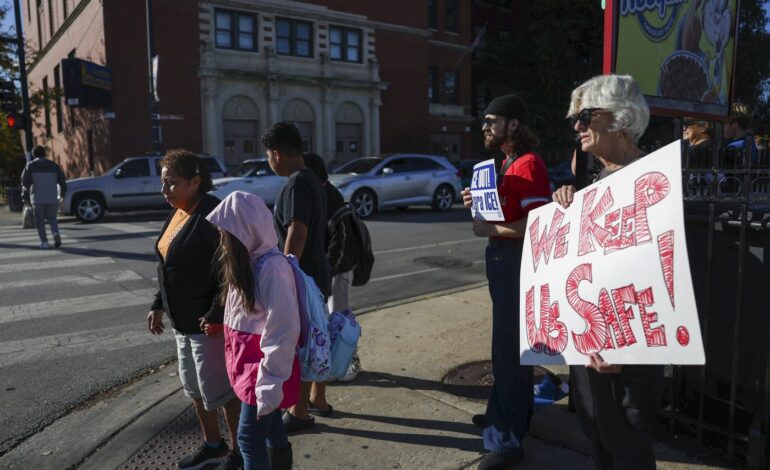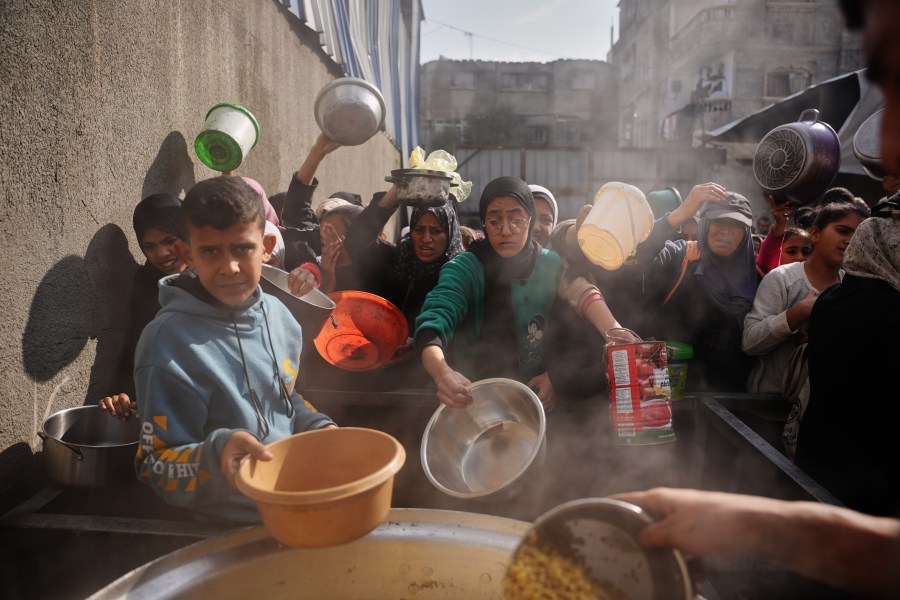Chicago Families Face Fear as ICE Raids Affect School Life

The impact of intensified immigration enforcement is resonating throughout Chicago and its surrounding suburbs, particularly affecting the daily lives of families and students. As fears of U.S. Immigration and Customs Enforcement (ICE) raids loom large, schools are grappling with how to maintain a safe environment for their students.
Monica Perez, a mother of seven, navigates the streets near Funston Elementary School in Logan Square with her children, keenly aware of the dangers that have emerged in recent weeks. Originally from Mexico, Perez arrived in the United States in 2007 without authorization. Despite her children being U.S. citizens, the heightened presence of federal agents has transformed school pickup routines into moments of anxiety.
“Rápido,” she urges her children, hastening their steps as they traverse the area. “Quickly.” Just the day before, she chose to keep her younger children home due to reports of ICE activity near the school. In her own words, “Ahorita, ando con miedo, pero los tuve que traer,” which translates to, “I’m scared right now, but I had to bring them.”
As the Trump administration’s immigration crackdown intensifies, the ripple effects are felt across Chicago Public Schools (CPS) and neighboring districts. School staff are working diligently to provide necessary support, while volunteers have organized community patrols to ensure the safety of students during arrival and dismissal times.
CPS is responding to these concerns by expanding its 24-hour Student Safety Center, which will include a dedicated team to address incidents involving federal law enforcement. This initiative allows school leaders to report incidents and receive immediate guidance. CPS interim Superintendent, Macquline King, acknowledged the challenges families are facing, stating, “We understand the weight many of our families are carrying.”
Since the launch of “Operation Midway Blitz” in September, over 800 arrests have been made in the Chicago area according to the U.S. Department of Homeland Security. While the operation aims to target individuals with criminal records, many of those detained have no prior offenses. The uncertainty surrounding these actions has led to lockdowns in several schools and the cancellation of events, as parents grow increasingly concerned about their children’s safety.
Earlier this month, an incident involving federal agents deploying tear gas near Funston Elementary forced recess indoors. Volunteers quickly mobilized, surrounding the school to provide support during dismissal. Evelyn Medina, a local business owner, has taken a proactive approach by distributing whistles and “ICE Out!” signs to assist in keeping students safe. “I was afraid for the children,” Medina remarked, highlighting the community’s commitment to protecting its youngest members.
Another community member, Carson Bell, expressed similar fears, emphasizing the targeting of parents during school drop-off and pick-up times. “How can you plan to face something like that, especially when they’re teargassing right outside?” he questioned, reflecting the anxiety that permeates the area.
Schools across the city are implementing various measures in response to the rising tensions. For instance, at Hibbard Elementary in Albany Park, parents have organized a “walking school bus” to ensure children can travel to and from school safely. Parent representative Maggie Cullerton Hooper described the effort as “enormous,” stressing the importance of sustainability in community support.
The reach of ICE activity is not limited to Chicago; neighboring suburban districts are also feeling the effects, particularly in communities with significant Latino populations. Reports indicate that parents are even hesitant to send their children to school, fearing what might happen during their commutes.
Teachers, like Marisa Mills from Unity Junior High in Cicero, are witnessing the emotional toll on their students. Many express concerns about their families’ safety, leading to difficulties in concentration. Mills shared, “I’ve had students tell me, ‘I’m really worried about my family… I’m scared that something is going to happen,’” emphasizing the emotional strain students are currently facing.
Parents like Marlene Diaz are also feeling the impact. She receives distressing messages from her 10-year-old son during the school day, pleading for early pickups. The fear of deportation looms large, with some children opting to stay home altogether. “It’s just hard. All the time, he’s like, ‘Mom, what about if they deport my friends?’” Diaz lamented.
Experts warn that the ongoing fear of immigration enforcement can severely disrupt children’s learning environments. The concept of ambiguous loss, described by clinical child psychologist Rebecca Ford-Paz, highlights how the uncertainty regarding a loved one’s status can lead to chronic anxiety, affecting a child’s ability to thrive.
Signs of ICE presence can exacerbate existing issues related to absenteeism, which has been on the rise following the COVID-19 pandemic. Rebecca Vonderlack-Navarro, vice president of education policy and research at the Latino Policy Forum, expressed her concerns about the long-term impacts of these developments, stating, “This is the antithesis of a safe and steady and inclusive learning environment that students need to do well successfully.”
In light of these challenges, parents and community groups have called for additional support from CPS, including expanded safe zones and options for remote learning. The Chicago Teachers Union has also urged the district to prepare for potential remote learning scenarios, yet CPS has not provided clarity on whether such plans are in place.
At a recent Board of Education meeting, Kia Banks, president of the Chicago Principals & Administrators Association, highlighted the difficulty school leaders face in addressing the ICE threat, urging the district to reconsider its attendance metrics given the current climate. “It is tone-deaf right now to ask about enrollment and attendance when parents are afraid to take their children to school,” she stated.
Amid these concerns, families like Diaz’s continue to navigate their daily lives under the shadow of uncertainty. “¿Qué más podemos hacer?” she questioned, meaning, “What else can we do?” as she guided her son Eduardo, who requires additional support due to his autism.
The fear stemming from ICE activity has transformed the landscape of education in Chicago, leaving parents, students, and educators searching for solutions to ensure safety and stability in their communities.






